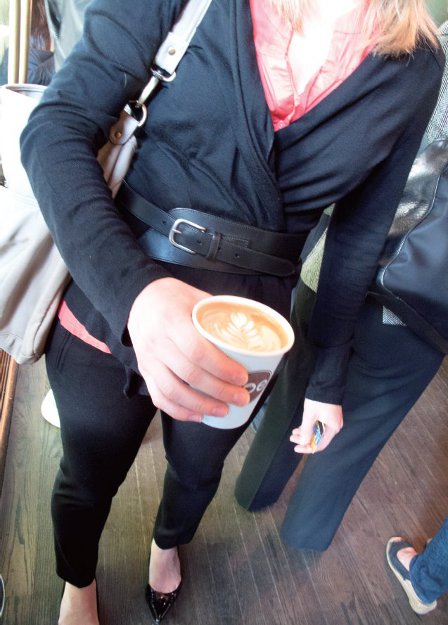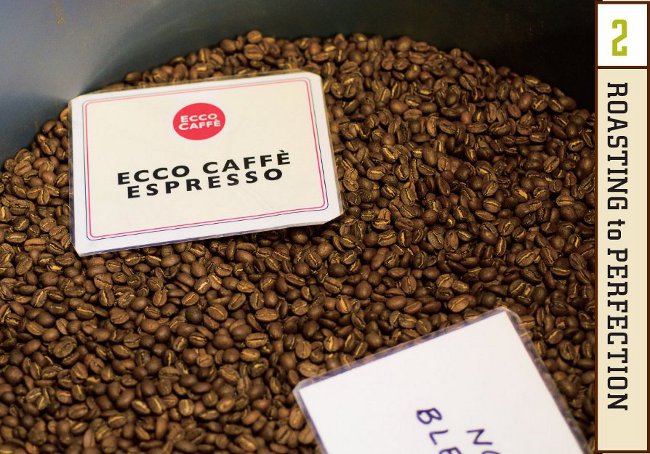
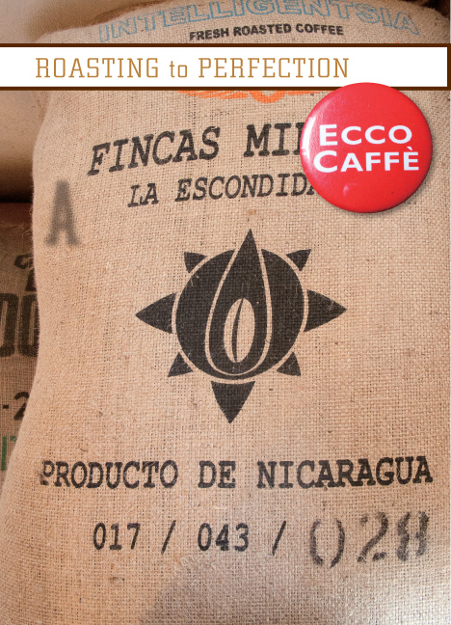
As we have seen, long before the beans are delivered to the barista, very small samples of lightly roasted beans are “cupped” (see pages 30 and 38) to determine the qualities and/or faults of an entire batch. In the specialty coffee trade, this is done in a cooperative tasting between the buyer and either the farmer or skilled cuppers at the final point of processing. Once cupped and selected, the beans are shipped to the roasting facility—in the case of all joe coffees, that would be either at Ecco Caffè in Santa Rosa, California, or at its sister company in Chicago, Intelligentsia Roasting Works. The beans continue to be cupped throughout the profiling process to determine the roasting approach that maximizes the quality inherent in the bean. Although an optimal roast profile can be met on the inaugural roast, it often takes many cuppings to determine the perfect roast for each coffee.
Cupping coffee is an art, one almost unknown to otherwise skilled culinary professionals. This tasting method is used by specialty coffee growers and by all buyers, roasters, and baristas to evaluate the flavor profile and aroma of individual coffees from a specific region. It is an essential element of the roasting process because, by continually cupping, the cupper learns to distinguish all of the desirable characteristics of a specific specialty coffee and how the roast can emphasize them.
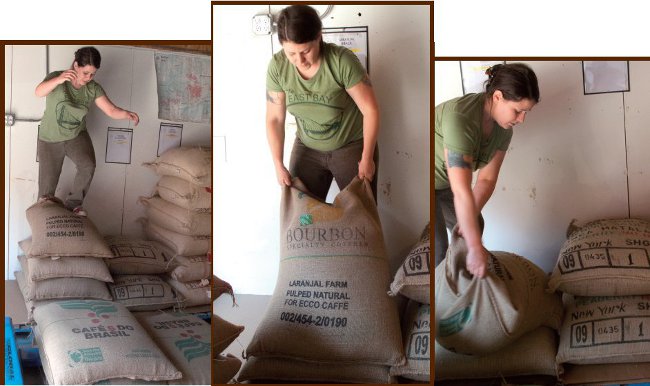
The purpose of roasting coffee is to bring out the inherent flavors of the green bean. Although the green beans contain many of the same qualities and chemicals as roasted beans, they do not have the flavors. The characteristic notes that identify a specific coffee can only be gained through the chemical reactions brought about by proper roasting. The roasting process should be done as close to when the brewed coffee will be consumed, since roasted coffee beans quickly begin to lose their fresh taste and the flavor profile begins to rapidly diminish. Interestingly, green beans are very dense and flavorless and would be almost impossible to process into ground coffee.
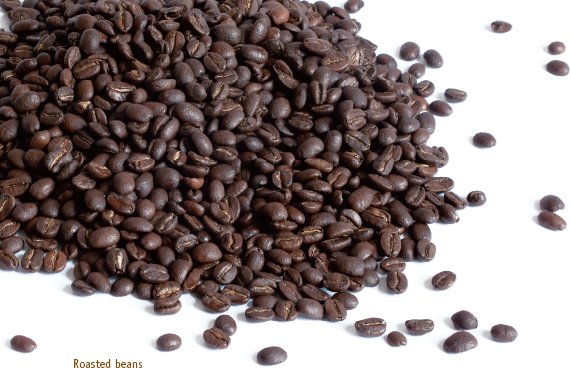
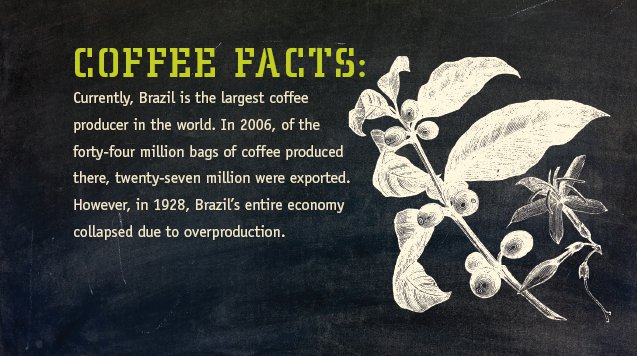
Cooperative ventures between producers and buyers have increased the specificity of each producer/region/micro-lot, varietal, and terroir (including soil type, elevation, climate, etc.), while processing, sorting, milling, and shipping improvements have allowed the specialty coffee industry to identify high-quality coffees. Through new and innovative advances made by buyers and producers, quality continues to improve, and producers are rewarded with higher prices and recognition as true artisans in their field. All of these details lead to nuances in the cup. On the consumer side, these changes require an educated palate that can appreciate these nuances. An analogy that is often made is to the improvements in quality wine production and educated consumers.
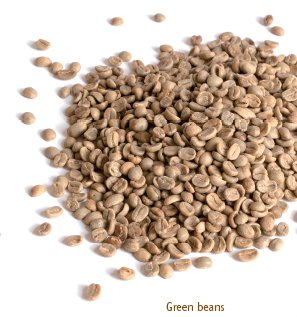
Once the beans arrive at the roastery, the roasting process begins by using a small test roaster to set the temperature, time, and air flow. Sample roasting is valuable in determining the quality of the samples submitted by farmers and importers. However, quality roasters know that sample roasting can be helpful in understanding what a production roast might taste like. Because the sample roasting equipment is so much smaller than the production roasting equipment, the sample roasting can produce variable results. Sample roasts are evaluated to determine the potential flavor of a production roast; however, the qualities that emerge in the sample roast do not always translate into those of the larger production roasts. This is where the skill of the roaster comes to play.
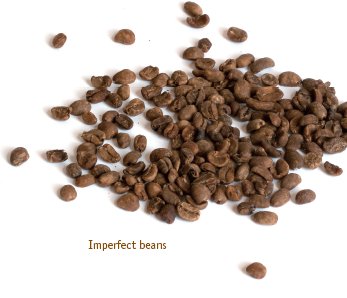
This test batch is cupped and scored, numerically, for sweetness, acidity, flavor, body, and finish with each category numbered from five to ten. Once all of the categories have been scored and totaled, the number forty is added, after which the cupper can add “Cuppers’ Points” so that they can adjust their score based on overall impression being greater than the sum of its parts, altogether resulting in the final score. The highest total score is one hundred, and it has rarely been reached. In order to be considered a “specialty” coffee, a coffee must score a minimum of eighty points with eighty-three being the benchmark. To qualify for the Cup of Excellence auction, the coffee must score eighty-four points. Cup of Excellence Presidential Award coffees are further distinguished with a score of ninety points and above. When we cup at joe (see pages 30 and 38), we do not score coffees since this rating has already been done at the time of purchase. We simply judge through descriptive phrases, which help the barista explain the nuances of a coffee to the customer.
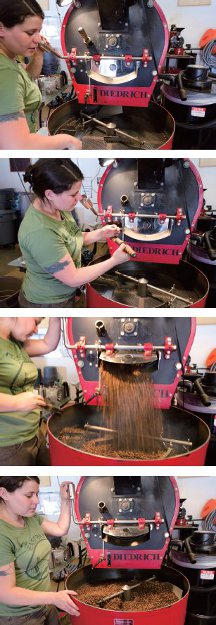
Since it is the role of the roasting process to ensure that a coffee’s distinguishing features are highlighted, the process is part science and part art. Observing small-batch specialty coffee being roasted is an extraordinary experience. Although the process is mechanical, the roaster stands continual guard, listening for the popping noises that indicate the various points of doneness and monitoring the time, temperature, gas level, air flow, aroma, and appearance of the roasting beans. Throughout the day, the roasted beans are cupped to ensure that the roaster has maintained the desired profile. The ongoing roast profiling is essential as coffees can change as they rest further in the roaster or undergo environmental changes. As you can imagine, to do justice to the hard work of the producer, profiling is exceedingly important, particularly with the expensive micro-lots that may consist of only a few bags of green beans.
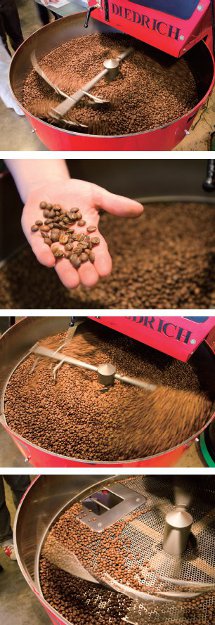
Once the roasted beans are tumbled onto the cooling bin, the art of the skilled roaster is evident. As a turning mechanism slowly aerates the cooling beans, the roaster carefully eyes the batch and, by hand, picks out any beans that don’t measure up to the defined standard. They might be cracked, suffer from mill damage, be too small, or be “quakers,” which appear as beans that are much more lightly roasted but are, in fact, cherries that were underdeveloped at harvest. These are all imperfections that only a trained eye can see, and the process can only be done at a small-batch facility by a highly skilled roaster.
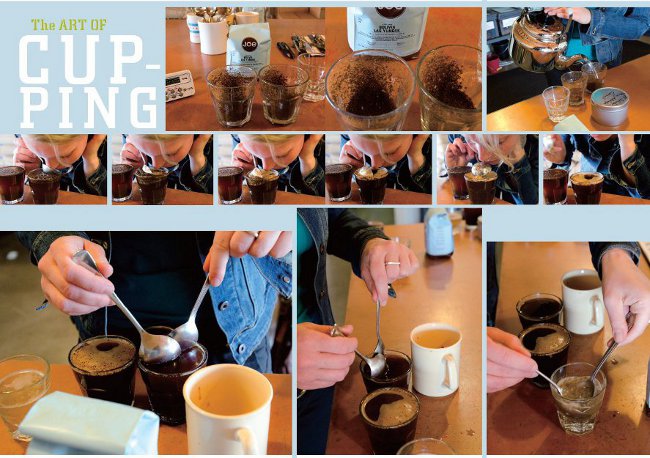
BREAKDOWN OF A PROFESSIONAL ROASTER/CUPPER’S COFFEE SCORING
| 95–100 | Clean, sweet, all characteristics exceptional, unbeatable |
| 90–94 | Clean, sweet, all characteristics terrific with multiple exceptional qualities |
| 85–89 | Clean, sweet, enjoyable characteristics with one or two excellent definable qualities |
| 80–84 | Necessary rating to designate specialty coffee; clean with mostly pleasant qualities |
| 75–79 | Cannot be designated as specialty coffee; negative qualities distract from the desired flavor |
| 70–74 | Elements that are aggressively unpleasant |
| 65–69 | Significant, outstanding defect |
| Less than 65 | Totally undesirable; undrinkable |

At the small Ecco Caffè roastery in Santa Rosa, our joe coffee beans are done in extremely small batches. These roasts are done in a 1999 Dietrich drum roaster that holds only sixteen pounds of green beans. The roaster must run continually throughout the day and, often, into the evening to produce the ever-changing and growing amount of coffee we use at joe weekly. Larger batches are roasted at Intelligentsia Roasting Works in Chicago in vintage Gothat machines. Along with Amanda Byron, we frequently visit the roasteries and are partners in the ongoing tasting of the product before it is released to our stores.
Many types of roasting machines exist, but all joe coffees are roasted in drum roasters. The process begins with the green beans placed in a hopper that lowers them into a drum. The heat source is under the drum, and as the drum turns, the beans are tumbled and evenly roasted. The roaster can watch the process through a small window called a sightglass and, from time to time, remove a few beans using a trier to gauge the degree of doneness.
Green beans are generally roasted between 380°F and 400°F. The entire process takes 11 to 14½ minutes with the first crack (the popping noise associated with roasting beans) occurring at 8 to 11 minutes. During the intense heat of the short roasting process, the sugars in the beans become caramelized, giving the coffee its ultimate flavor. Although the beans swell during roasting, they also lose volume so that the starting weight drops by 15 to 18 percent.
There are, of course, varying degrees of roast. It is up to the roaster and the barista to determine the roast profile that best highlights each particular coffee. At joe we work closely with our roastery to determine the coffees that best meet our profile. The same attention to quality is given to the roasting of all of our beans, caffeinated or not, so much so, that we feel that joe decaf sings with the same deliciousness as all of our regular coffees. A lightly roasted coffee will range in color from cinnamon to milk chocolate while a dark roast can be almost ebony with a shiny exterior. Lightly roasted coffees are generally more acidic and bright tasting, reflecting their origin, while very dark roasts can be almost bitter on the palate. It should go without saying that we prefer the lighter roasts!
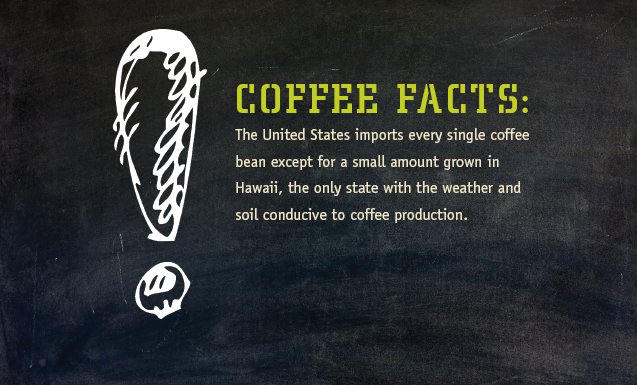
When the beans are extremely dark, the coffee will often taste more of the roasting than of the complexities of the bean. Although you will not find dark roasts at joe, it is interesting to note that the darker the roast the less the caffeine content. The lessening of caffeine occurs during the longer roasting period where the inherent oils are drawn to the surface of the bean.
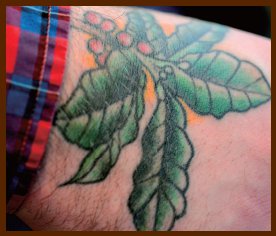
In the current rage to return to the earth, some roasters in the United States have gone back to roasting green beans over fruit wood, a traditional method that is still practiced in some areas of Italy. These traditionalists feel that the smoke from the fruity wood adds an intriguing dimension to the roasted beans, imparting an otherwise unfound sweetness as well as enhancing the bean’s natural essence.
Immediately after roasting, the beans are packed according to their origin, with the exception of our joe house coffee and our espresso blends, which are normally a blending of various beans to achieve the notes that we feel best identify a joe flavor profile. Each bean in each blend is labeled by origin with as much care as the single origin filter offerings. This is again where art intersects science as the roaster, working with the barista, carefully unites the qualities of the beans that will together create a distinctive cup of joe.
Freshly roasted specialty coffee beans have a brief shelf life, optimally no more than two weeks. Once roasted, coffee beans begin to stale quite rapidly. They must be kept from exposure to light, heat, moisture, and oxygen to ensure that they stay fresh for even this minimal length of time. At joe our beans are packed in one-way valve bags with a pressure-relieving button that allows naturally accumulating carbon dioxide to escape. The insulation keeps the beans as fresh as possible during the optimal storage period. However, once opened, the entire bag should be placed in an airtight container. We do grind beans to order but suggest that consumers grind only the amount they need immediately, since ground coffee quickly becomes stale. Under no circumstances should the beans be refrigerated since they will pick up the undesirable odors of the refrigerator or freezer, damaging their purity.
